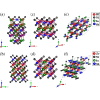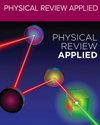Double half-Heusler alloys X2Ni2InSb (X = Zr, Hf) with promising thermoelectric performance: The role of varying structural phases
IF 4.4
2区 物理与天体物理
Q2 PHYSICS, APPLIED
引用次数: 0
Abstract
Double half-Heusler (HH) alloys are a new class of compounds that can be seen as transmuted versions of two single half-Heusler alloys with higher flexibility of tunability of their properties. Here, we report a detailed study of the thermoelectric (TE) properties of two double HH alloys ( = , ), using first-principles calculation. These alloys exhibit a rich phase diagram with the possibility of tetragonal, cubic, and solid-solution phases. As such, a comparative study of the TE properties of all these phases is highly desired. The simulated band gap, obtained using a hybrid functional, of the ordered phase of and lies in the range 0.24–0.4 and 0.17–0.59 eV, respectively, while, for the disordered phase, it lies in between 0.05 and 0.06 eV. A simulated TE figure of merit () as high as 2.02 and 2.45 is obtained for and , respectively. In both compounds, electronic transport plays the dominant role in achieving the promising values. We believe this study will attract the attention not only of experimentalists but also of theoreticians from the thermoelectric community to further investigate similar double HH alloys.

具有良好热电性能的双半赫斯勒合金 X2Ni2InSb(X = Zr、Hf):不同结构相的作用
双半休斯勒(HH)合金是一类新型化合物,可以看作是两个单半休斯勒合金的变形版本,具有更灵活的可调性。在此,我们报告了利用第一原理计算对两种双 HH 合金 X2Ni2InSb(X = Hf、Zr)的热电(TE)特性进行的详细研究。这些合金显示出丰富的相图,可能存在四方相、立方相和固溶相。因此,对所有这些相的 TE 特性进行比较研究是非常必要的。使用混合函数得到的 Hf2Ni2InSb 和 Zr2Ni2InSb 有序相的模拟带隙分别为 0.24-0.4 和 0.17-0.59 eV,而无序相的模拟带隙在 0.05 和 0.06 eV 之间。Hf2Ni2InSb 和 Zr2Ni2InSb 的模拟 TE 优度(ZT)分别高达 2.02 和 2.45。在这两种化合物中,电子传输在实现良好的 ZT 值方面发挥了主导作用。我们相信,这项研究不仅会引起实验人员的注意,也会引起热电界理论人员的注意,以进一步研究类似的双 HH 合金。
本文章由计算机程序翻译,如有差异,请以英文原文为准。
求助全文
约1分钟内获得全文
求助全文
来源期刊

Physical Review Applied
PHYSICS, APPLIED-
CiteScore
7.80
自引率
8.70%
发文量
760
审稿时长
2.5 months
期刊介绍:
Physical Review Applied (PRApplied) publishes high-quality papers that bridge the gap between engineering and physics, and between current and future technologies. PRApplied welcomes papers from both the engineering and physics communities, in academia and industry.
PRApplied focuses on topics including:
Biophysics, bioelectronics, and biomedical engineering,
Device physics,
Electronics,
Technology to harvest, store, and transmit energy, focusing on renewable energy technologies,
Geophysics and space science,
Industrial physics,
Magnetism and spintronics,
Metamaterials,
Microfluidics,
Nonlinear dynamics and pattern formation in natural or manufactured systems,
Nanoscience and nanotechnology,
Optics, optoelectronics, photonics, and photonic devices,
Quantum information processing, both algorithms and hardware,
Soft matter physics, including granular and complex fluids and active matter.
 求助内容:
求助内容: 应助结果提醒方式:
应助结果提醒方式:


